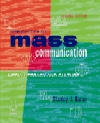Stanley J. Baran
| affiliate
|
a broadcasting station that aligns itself with a network
|
 |
 |
 |
| AM/FM combo
|
two stations, one AM and one FM, simultaneously broadcasting identical content
|
 |
 |
 |
| audion tube
|
vacuum tube developed by DeForest that became the basic invention for all radio and
television
|
 |
 |
 |
| billings
|
total sale of broadcast airtime
|
 |
 |
 |
| Biltmore Agreement
|
settled the press war between newspapers, which had refused their services to their
electronic competitors, and radio
|
 |
 |
 |
| bitcasters | "radio stations" that can be accessed only over the World Wide Web
|
 |
 |
 |
| catalogue albums
|
albums more than three years old
|
 |
 |
 |
| conduction system
|
wireless communication system using signals sent through water and ground
|
 |
 |
 |
| cover | rerecording of one artist's music by another
|
 |
 |
 |
| deregulation
|
relaxation of ownership and other rules for radio and television
|
 |
 |
 |
| digital audio radio service (DARS)
|
direct home or automobile delivery of audio by satellite
|
 |
 |
 |
| digital audio tape (DAT)
|
introduced in the early 1970s, offers digital quality sound purity in a cassette tape format
|
 |
 |
 |
| digital recording
|
recording based on conversion of sound into 1s and 0s logged in millisecond intervals in
a computerized translation process
|
 |
 |
 |
| DMX (Digital Music Express)
|
home delivery of audio by cable
|
 |
 |
 |
| duopoly
|
single ownership and management of multiple radio stations in one market
|
 |
 |
 |
| format
|
a radio stationís particular sound or programming content
|
 |
 |
 |
| in-band-on-channel (IBOC)
|
digital radio technology that uses digital compression to ìshrinkî digital and analog
signals allowing both to occupy the same frequency
|
 |
 |
 |
| liquid barretter
|
first audio device permitting the reception of wireless voices; developed by Fessenden
|
 |
 |
 |
| microbroadcasters
|
low-power, community radio stations
|
 |
 |
 |
| MP3
|
file compression software that permits streaming of digital audio and video data
|
 |
 |
 |
| nonduplication rule
|
mid-1960s FCC ruling that AM and FM license holders in the same market must
broadcast different content at least 50% of the time
|
 |
 |
 |
| O&O | a broadcasting station that is owned and operated by a network
|
 |
 |
 |
| P2P
|
person-to-person software that permits direct Internet-based communication or
collaboration between two or more personal computers while bypassing centralized
servers
|
 |
 |
 |
| playlist
|
predetermined sequence of selected records to be played by a disc jockey
|
 |
 |
 |
| radiation system
|
wireless communication system allowing reliable sending and receiving of signals
through the air
|
 |
 |
 |
| recent catalogue albums
|
albums that have been out for 15 months to three years
|
 |
 |
 |
| secondary service | a radio station's second, or nonprimary, format
|
 |
 |
 |
| spectrum scarcity
|
broadcast spectrum space is limited, so not everyone who wants to broadcast can; those
who are granted licenses must accept regulation
|
 |
 |
 |
| streaming
|
the simultaneous downloading and accessing (playing) of digital audio or video data
|
 |
 |
 |
| syndication
|
sale of radio or television content to stations on a market-by-market basis
|
 |
 |
 |
| trustee model | in broadcast regulation, the idea that broadcasters serve as the public's trustees or
fiduciaries
|
 |
 |
 |
| Web radio
|
the delivery of ìradioî over the Internet directly to individual listeners
|
 |
 |
 |
| wireless telegraph
|
early efforts at long-distance communication that led to development of radio
|
 |
 |
 |
| wireless telephony
|
early efforts at long-distance voice communication that led to development of radio
|



 2002 McGraw-Hill Higher Education
2002 McGraw-Hill Higher Education